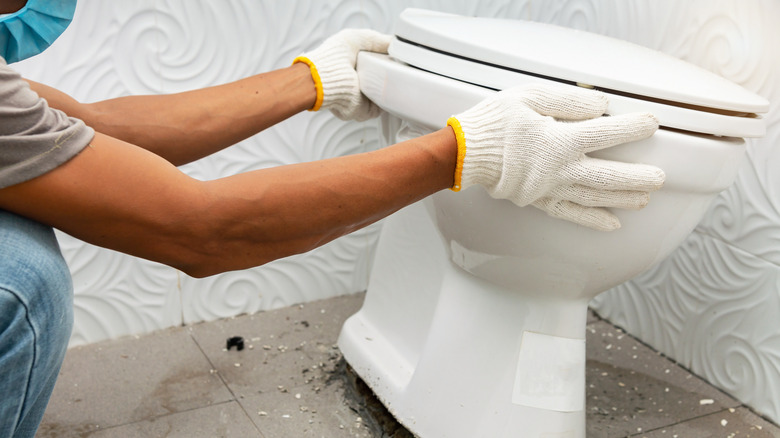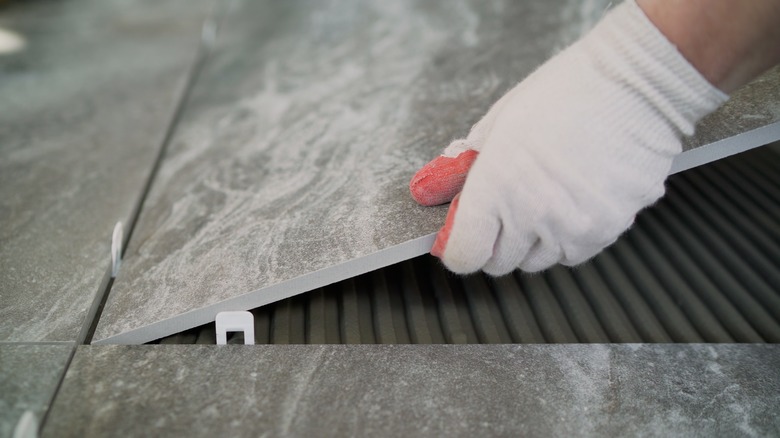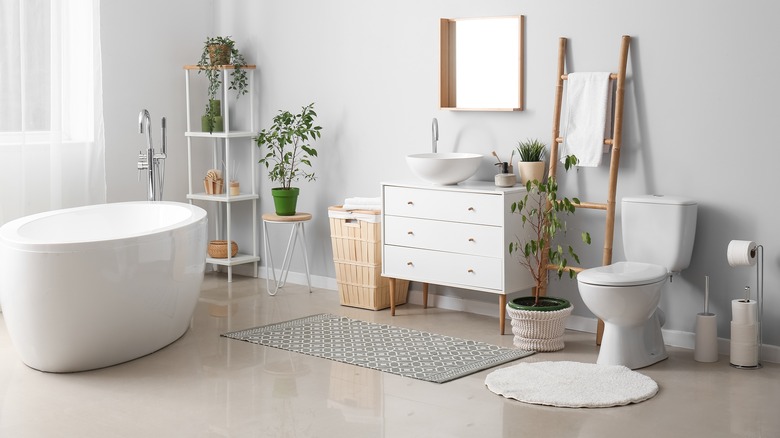Should You Install A Toilet Before Or After New Flooring? Our Plumbing Expert Weighs In
If you're thinking of switching up the toilet and flooring in your bathroom, it may seem like a breeze for the most part. However, if you have minimal experience or it's your first time doing it, you may wonder: "Do I install the toilet before or after the flooring?" Thankfully, we spoke to the VP of Operations of Benjamin Franklin Plumbing, Joseph Wade, to get you all the answers you need in an exclusive interview with House Digest. So, in which order should you be doing things?
Well, when it comes to installation, he explains: "When undergoing a bathroom renovation that involves new flooring and a new toilet, we always recommend installing the flooring first. This will ensure that when you install your new toilet, the toilet flange (which connects the toilet to the floor and drain pipe) is sealed on an even surface level and properly attached to your plumbing." This applies to any type of flooring, whether tile, marble, laminate, or vinyl. Like with any project, if you're doing it yourself, you should always take the time to ensure that you're installing your flooring correctly; otherwise, it may be challenging to correct everything at a later date or after the toilet has gone down, not to mention the extra costs you may incur for your errors.
Benefits of adding flooring first
Now you know why it's better to lay down your flooring first. However, there are some other additional benefits of doing it this way. Speaking exclusively to House Digest, VP of Operations of Benjamin Franklin Plumbing, Joseph Wade, dives into further detail as to why it's so important: "It also will prevent leak paths from forming, which can be damaging to your home and costly to fix. Additionally, installing the flooring first allows you to avoid the tedious process of cutting your material (typically tile) into awkward shapes or sizes to fit around an already-installed toilet and gives your bathroom a cleaner finish." So, if you want a top-quality end result when renovating your bathroom, it's a good idea to follow these steps to achieve that.
If you suspect any leaks, then this is a sign to call a plumber to fix your bathroom. This applies to both before and after you fit any new flooring or toilet, as the issue will need to be rectified before you can proceed with your re-design. This way, you'll end up with a fully functional new bathroom that you can be proud to call your own.
Other things to keep in mind
While it can be a great way to cut costs by installing your flooring and toilet yourself, you may want to think twice if you're looking to save money in the long term. As it turns out, fitting a new toilet may be trickier than it seems. Speaking exclusively to House Digest, VP of Operations of Benjamin Franklin Plumbing, Joseph Wade, explains why: "Installing a new toilet, or removing an old one, can be a difficult task without prior knowledge or experience in plumbing, and may result in damage to your home or costly repairs if done incorrectly. We recommend consulting a licensed and local plumbing technician when undergoing a bathroom renovation like this." Of course, if you're highly experienced in this field or a plumber yourself, this may be no problem for you. However, it's always best to err on the side of caution.
If you're unsure where to find someone experienced, your best bet is to research local companies, look at reviews, and ask around for recommendations. It's always important to look at the history and feedback of a company, as it can help you avoid a botched renovation job and get the best value for your money. Likewise, when it comes to your flooring, just make sure to pick the best material for your bathroom floor. For example, you'll want to choose something easy to clean that won't lock in moisture.


